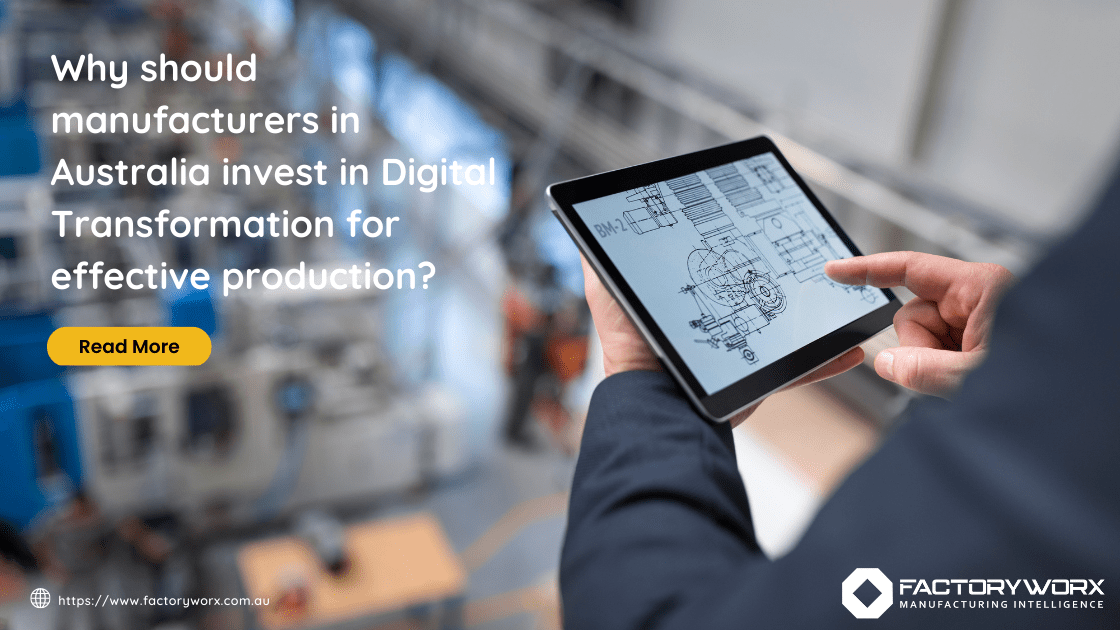
- December 27, 2022
- admin
- 0
Read Our Blog

Why should manufacturers in Australia invest in Digital Transformation for effective production?
Digital transformation is expanding in the entire manufacturing sector. If manufacturing firms are unable to understand what's best for them it will result in unproductive employees, outdated processes in the coming future.
Many businesses have started to experience the long-term advantages of manufacturing automation in Australia. If you, too, wish to go digital, you can gain a lot from higher productivity, optimised data use, increased scope of innovation, and overall cost reduction.
But how to bring a digital transformation to your manufacturing business? What are some typical pitfalls you should be aware of? Let's take a look at it.
Why Should Manufacturing Companies Invest in Digital Transformation?
Innovation
You won't ever regret investing in the digitalisation of your manufacturing company. Investing in the appropriate digital infrastructure, tools, and software will be worthwhile because it will provide your staff with cutting-edge equipment that will help your company move forward.
Reduce costs
You can improve your understanding of problems like delivery status, inventory levels and demand cycles with the help of digital manufacturing. By having more information, you can be in a better position to handle supply and demand fluctuations. The risks and expenses associated with items like excess inventory and the material will be reduced.
Resiliency
Resilience is essential to thriving in challenging business situations. In order to stay ahead of the competition, manufacturers must be able to predict and respond to problems. Digital technologies benefit manufacturing by utilising flexible automation, connecting the supply chain effectively and allowing remote operation.
Improved process and equipment reliability
Unplanned downtime is estimated to cost manufacturers $50 billion yearly. Predictive maintenance, enabled by digital technology, might hold the key to addressing this heavy price tag.
Predictive maintenance is an approach that seeks to boost reliability by taking corrective measures before a breakdown event happens. By employing this strategy, firms may ensure that their assets are effectively maintained while saving their own companies' internal resources from unnecessary maintenance work.
The common pitfalls of scaling digital transformations in manufacturing
- Failure to adapt: Employing a one-size-fits-all strategy, manufacturers miss the chance to incorporate the adaptability and customisation required to take advantage of the distinct conditions, cultures, and values of various industrial sites.
- Analysis paralysis:Conducting a thorough and in-depth analysis of the whole network can leave a manufacturer out of steam before a change can get off the ground. Instead, accurate, robust insights can provide an accurate extrapolation methodology.
- Technology-driven rather than value-driven : When solutions are implemented using a technology-first approach, there is no clear connection between them and real value possibilities, business difficulties, or capability needs. This creates difficulties while implementing the manufacturing process.
The four principles for getting the best out of Industry 4.0
Be specific: Concentrate on actual business requirements and existing performance issues, adopt a "strengths upward" strategy, and build on any successful site-specific solutions that can be carried out pragmatically across the network.
Design a digital-manufacturing road map: Create a prioritised rollout plan that includes a clear scaling strategy, an explanation of the value that will be realised over time, integration of data enablement and IT/OT architecture, resource requirements, capability requirements, and change management.
Educate, not eliminate: When it comes to implementing Industry 4.0 solutions, it makes more sense to adapt present human resources rather than putting employees for termination. Instead of replacing employees, new technologies promise to transform the nature of work.
Cybersecurity: Manufacturers' cybersecurity risks will certainly rise as they integrate more technology into their processes and as those systems become more interconnected. This implies that a planned cybersecurity strategy must be the underpinning for every Industry 4.0 project.
Fortunately, dealing with cybersecurity doesn't have to be a time-consuming and expensive endeavour.
Characteristics of a smart manufacturing factory
Data analysis for optimal decision making
Interconnected machinery and embedded sensors generate a large amount of big data for manufacturing businesses. Manufacturers can analyse past trends, spot patterns, and improve decisions with the use of data analytics.
To gain deeper insights, smart factories can also use data from other areas of the business and their wider ecosystem of suppliers and distributors. By analysing information from human resources, warehousing or sales. Manufacturers can decide what to produce depending on personnel and sales margins.
IT-OT integration
The network architecture of the smart manufacturing factory depends on interconnectivity. Real-time data gathered from sensors, devices, and machines on the factory floor can be shared with other enterprise software stack components, such as enterprise resource planning (ERP) and other business management software, and used immediately by other factory assets.
Custom Manufacturing
Smart factories can more effectively generate goods that are personalised to each client's needs. In fact, smart factories enable manufacturers to attain maximise productivity in a cost-effective manner across a wide range of industrial segments.
Manufacturers may quickly produce small batches of specialised items for specific clients utilising cutting-edge simulation software applications, new materials, and technologies like 3-D printing. The first industrial revolution was focused on mass production, whereas Industry 4.0 was concerned with mass customisation.
Supply chain
A reliable Industry 4.0 strategy must integrate manufacturing operations with a transparent, effective supply chain, which is essential to industrial operations. This influences the way manufacturers resource their raw materials and supply their finished products.
Manufacturing companies can better schedule deliveries by sharing production information with suppliers. Additionally, businesses can utilise predictive shipping to deliver finished goods at the right time to fulfil consumer demand by evaluating weather, transportation partner, and retailer data. Blockchain is rapidly becoming a crucial technology for enabling supply chain transparency.
Digital transformation in manufacturing opens up various opportunities that include effectiveness, customisation, agility and automation. Manufacturing businesses must invest in digital capabilities, technologies and software to stay relevant in their industry and plan for the future. These investments will provide them with a competitive advantage in a market that is already hypercompetitive.

